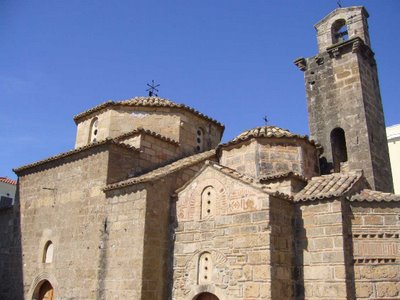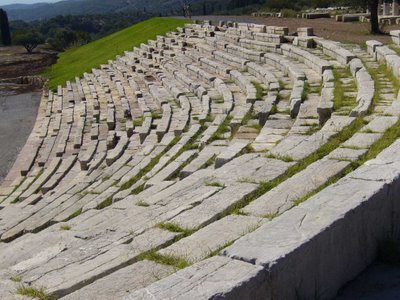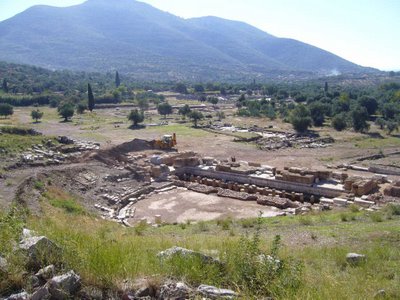Peloponnese Day 5: Ancient Messene
 Chamber tomb at Thourion.
Chamber tomb at Thourion.
 Two churches in the old center of Kalamata.
Two churches in the old center of Kalamata. Stadium at Messene.
Stadium at Messene.
No native literary tradition until Messene (369) founded. Surveys done in the area, like Malthi in the Soulema Valley (near Peristeria) – Mycenaean fortified citadel; Ag. Flouros area – thought related to a sanctuary of Artemis or Aphrodite. 1960’s: Minnesota Messenia Expedition did a major “extensive survey.” Talked to local farmers about what’s here. Informal survey walking. They list where they went with notes of what they saw on the surface. Had geologists (Rapp) – studied seacoast change by looking at potential for erosion; described hydrogeology of the area. “Extensive” = not systematic, not random sample – went where they thought would be good places to go.
In the 1990’s, Pylos Regional Archaeological Project, “instensive” survey – 10m apart markers, teams of 5-8 people, systematic. You cover everything, local or not. Random selection of these areas. Based on altitude (get some stuff at various altitudes). Unbiased by “likelihood.” Also multidisclipinary – geologists did cores, botanists/archaeobotanists looked at pollen – can indicate change in climate. Ethnographers talked to locals about their feelings about boundaries/backgrounds; historians (like Sue Alcock); pottery experts. Result: wanted to trace hinterland of Bronze Age Nestor’s Palace. See how the palace slowly increases hegemony on this side of Aigaleon, later on the other side. After Bronze Age, fire destroyed the palace. Not reoccupied. Population drops very dramatically: a very large town outside the palace, lots of LHIIIA-B, very little LHIIIC. Big gap in early Dark Age. Differs from finds at other surveys. Usually, there are a few larger centers, then later towns with small hamlets in between. Here we find huge nucleated sites with lots of empty space in between. Spartans try to control them, so maybe having them dispersed would be harder to control. Population increases Hellenistic -> Roman period. Could be generalized for western Peloponnese, oriented more toward Italy, whereas before was the “backside” of an Aegean-oriented Greece. Survey pottery is not stratified, harder to date precisely. You need a stratified excavation to date more sensitively.
 Sculpture from the Kalamata Archaeological Museum.
Sculpture from the Kalamata Archaeological Museum. Ekklesiasterion at Messene (according to Themelis).
Ekklesiasterion at Messene (according to Themelis). Fortifications at the Arcadian Gate, Messene.
Fortifications at the Arcadian Gate, Messene. Sculpture from the Messene Museum.
Sculpture from the Messene Museum. The theater at Messene.
The theater at Messene.
The Messenian Wars
Pausanias says: Polychares (a Messenian), whose son was killed by a Spartan, starts killing Spartans, and the Spartans react appropriately. Raids back and forth, indecisive battles. Messenians are stuck in Mt. Ithome, which Spartans besiege. Eventually they surrender to the Spartans, but did not become slaves at this point.
Tyrtaios: Messenians had to give 1/2 of their produce to the Spartans, grieve for the dead Spartan king, and take an oath not to revolt.
.… 30 years later …. Aristomenes leads Messene into the 2nd war. Ends up as an outlaw, betrayed, escapes a lot. Doomed to fail of course. More Messenians flee to Rhegion (Reggio di Calabria). Everyone else becomes helots.
We can’t trust Pausanias, for many reasons. E.g.: dating. Tyrtaios indicates that the wars did take place, and we date Tyrtaios to the wars and vice versa. Stylistically, no later than 640. Perhaps Tyrtaios is a fictional archaizing figure. Or, last Messenian victor in Olympics was in 8th century.
Epaminondas: 230 years after enslavement, freed them. Down-date 68 years. Pausanias’ source is an epic poet of Crete, who mentions a king, Pausanias hadn’t heard of him, so rejected it. If we date the war to late C7 (when the other king reigned) it’s okay. Helped to found Rhegion after the first war: pottery from there contributes to the argument. Pausanias himself has dating discrepancies. Compared to Thuc. and Hdt. even. If we down-date everything (664 -> 499), Battle of Thyreia (Spartans vs. Argives) Pausanias dates very early; down-dated to 547, which matches Hdt. Other events work like this. If we recalibrate thusly, 2nd war inds in 495. A Messenian revolt prevented the Spartans from helping the Athenians at Marathon – could this be the 2nd war? Other evidence kind of supports this. Why didn’t Hdt. know about the revolt in the 490’s? Why are the dates SO off in Pausanias? Tyrtaios mentions Messenians in frag. 23: “fighting” “us” “Messenians”. He’s probably C7. But what does it mean to be Messenian?
Odysseus comes here, and Messenians are described as being in Lacedaimonia. Iliad mentions Messe and Sparta. Maybe related? Probably not. Probably wasn’t a Messenia in C8. Spartan acquisition of the region – by the Classical period at least. Revolt of 460’s. Eventually the Messenians prevailed, Athenians allowed them to go to Naupactus. Messenian identity: those who revolt. They didn’t revolt because they were Messenians, but Messenians because they revolted.
Location of (in 369) the new Messene city. Isocrates: “Aristodemos” – (a Spartan king) deals with it – populated by ex-slaves/helots. Makes it look like Epaminondas is making an illegitimate state.
Archaeology suggests: sanctuaries here are thoroughly Lacedaimonian: Apollo Kourethos (related to Korus, Spartan Amyclae) found on the peninsula; Artemis in Taygetos (Laconic offerings), Kalamata Poseidon, Thouria Poseidon, Messene – motifs of Spartan type. Who was using the sanctuaries? Perioikoi? Had military training – makes sense since they won this freedom from Sparta. Later Messenians claimed that the Spartan cult of Dioskouroi, and Artemis Orthia were originally Messenian and taken away by Spartans. Among smaller ethnic groups, there is an aggregation to a larger identity. Tholos tomb at Nichoria.
Tholos tomb at Nichoria.

0 Comments:
Δημοσίευση σχολίου
<< Home